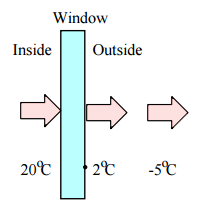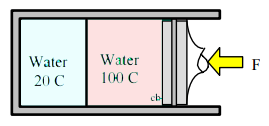This set of Thermodynamics Test focuses on “Entropy Generation in a Closed and Open System”.
1. 1 kg of air at 300 K is mixed with 1 kg air at 400 K in a constant pressure process at 100 kPa and Q = 0. Find the entropy generation in the process.
a) 0.0207 kJ/K
b) 0.0307 kJ/K
c) 0.0407 kJ/K
d) 0.0507 kJ/K
View Answer
Explanation: U2 – U1 + W = U2 – U1 + P(V2 – V1) = H2 – H1 = 0
H2 – H1 = mA(h2 – h1)A + mB(h2 – h1)B = mACp(T2 – TA1) + mBCp(T2 – TB1) = 0
T2 =(mATA1 + mBTB1)/(mA + mB) = (TA1/2) + (TB1/2) = 350 K
1S2 gen = mACp ln(T2/TA1) + mBCp ln(T2/TB1)
= 1 × 1.004 ln [350/300] + 1 × 1.004 ln[350/400] = = 0.15477 – 0.13407 = 0.0207 kJ/K.
2. A window receives 200 W of heat transfer at its inside surface of 20°C and transmits this 200 W from its outside surface at 2°C to ambient air at 5°C. Find the window’s rate of entropy generation. 
a) 0.015 W/K
b) 0.025 W/K
c) 0.035 W/K
d) 0.045 W/K
View Answer
Explanation: S (inside) = 200/293.15 = 0.682 W/K
S (window) = 200/275.15 = 0.727 W/K
S (ambient) = 200/268.15 = 0.746 W/K
Window only: S(gen win) = S(window) – S(inside)
= 0.727 – 0.682 = 0.045 W/K.
3. An insulated cylinder/piston contains R-134a at 1 MPa, 50°C, volume of 100 L. The R-134a expands, dropping the pressure in the cylinder to 100 kPa. The R-134a does 190 kJ of work against the piston during this process. Is that possible?
a) yes
b) no
c) cannot be determined
d) none of the mentioned
View Answer
Explanation: v1 = 0.02185 m^3/kg, u1 = 409.39 kJ/kg,
s1 = 1.7494 kJ/kg K, m = V1/v1 = 0.1/0.02185 = 4.577 kg
m(u2 – u1) = 1Q2 – 1W2 = 0 – 190 hence u2 = u1 − 1W2/m = 367.89 kJ/kg
T2 = -19.25°C ; s2 = 1.7689 kJ/kg K
m(s2 – s1) = ⌡⌠dQ/T + 1S2(gen) = 1S2(gen)
1S2(gen) = m(s2 – s1) = 0.0893 kJ/K
This is possible since 1S2(gen) > 0.
4. A hot metal piece is cooled rapidly to 25°C, removing 1000 kJ from the metal. Calculate the change of entropy if saturated liquid R-22 at −20°C absorbs the energy so that it becomes saturated vapor.
a) 1.950 kJ/K
b) 2.950 kJ/K
c) 3.950 kJ/K
d) 4.950 kJ/K
View Answer
Explanation: R-22 boiling at -20°C; m = 1Q2 /h(fg) = 1000/220.327 = 4.539 kg
∆S(R-22) = ms(fg) = 4.539(0.8703) = 3.950 kJ/K.
5. A hot metal piece is cooled rapidly to 25°C, removing 1000 kJ from the metal. Calculate the change of entropy if energy is absorbed by ice.
a) 2.662 kJ/K
b) 3.662 kJ/K
c) 4.662 kJ/K
d) 5.662 kJ/K
View Answer
Explanation: Ice melting at 0°C; m = 1Q2 /h(fg) = 1000/333.41 = 2.9993 kg
∆S(H2O) = ms(ig) = 2.9993(1.221) = 3.662 kJ/K.
6. A hot metal piece is cooled rapidly to 25°C, removing 1000 kJ from the metal. Calculate the change of entropy if energy is absorbed by vaporizing liquid nitrogen at 101.3 kPa pressure.
a) 9.929 kJ/K
b) 10.929 kJ/K
c) 11.929 kJ/K
d) 12.929 kJ/K
View Answer
Explanation: Nitrogen boiling at 101.3 kPa; m = 1Q2 /h(fg) = 1000/198.842 = 5.029 kg
∆S(N2) = ms(fg) = 5.029(2.5708) = 12.929 kJ/K.
7. A piston cylinder has 2.5 kg ammonia at -20°C, 50 kPa. It is heated to 50°C at constant pressure from external hot gas at 200°C. Find the total entropy generation.
a) 0.511 kJ/K
b) 0.611 kJ/K
c) 0.711 kJ/K
d) 0.811 kJ/K
View Answer
Explanation: v1 = 2.4463 m^3/kg, h1 = 1434.6 kJ/kg, s1 = 6.3187 kJ/kg K
v2 = 3.1435 m^3/kg, h2 = 1583.5 kJ/kg, s2 = 6.8379 kJ/kg K
1Q2 = m(h2 – h1) = 2.5 (1583.5 – 1434.6) = 372.25 kJ
1S2(gen) = m(s2 – s1) – 1Q2/T(gas)
= 2.5 (6.8379 – 6.3187) – 372.25/473.15 = 0.511 kJ/K.
8. A piston/cylinder contains 1 kg water at 20°C, 150 kPa. The pressure is linear in volume. Heat is added from 600°C source until the water is at 1 MPa, 500°C. Find the total change in entropy.
a) 1.751 kJ/K
b) 2.751 kJ/K
c) 3.751 kJ/K
d) 4.751 kJ/K
View Answer
Explanation: v1 = 0.001002 m^3/kg; u1 = 83.94 kJ/kg; s1 = 0.2966 kJ/kg K
v2 = 0.35411 m^3/kg; u2 = 3124.3 kJ/kg; s2 = 7.7621 kJ/kg K
1W2 = ½ (1000 + 150) 1 (0.35411 – 0.001002) = 203 kJ
1Q2 = 1(3124.3 – 83.94) + 203 = 3243.4 kJ
m(s2 – s1) = 1(7.7621 – 0.2968) = 7.4655 kJ/K; 1Q2/T(source) = 3.7146 kJ/K
1S2 gen = m(s2 – s1) − 1Q2/T(SOURCE) = ∆Stotal
= ∆S(H2O) + ∆S(source) = 7.4655 – 3.7146 = 3.751 kJ/K.
9. 1kg of ammonia is contained in a piston/cylinder, as saturated liquid at −20°C. Heat is added at 100°C until a final condition of 70°C, 800 kPa is reached. Assuming the process is reversible, find the entropy generation.
a) 1.007 kJ/K
b) 1.107 kJ/K
c) 1.207 kJ/K
d) 1.307 kJ/K
View Answer
Explanation: P1 = 190.08 kPa, v1 = 0.001504 m^3/kg, u1 = 88.76 kJ/kg, s1 = 0.3657 kJ/kg K
v2 = 0.199 m^3/kg, u2 = 1438.3 kJ/kg, s2 = 5.5513 kJ/kg K
1W2 =(1/2)(190.08 + 800)1(0.1990 – 0.001504) = 97.768 kJ
1Q2 = m(u2 – u1) + 1W2 = 1(1438.3 – 88.76) + 97.768 = 1447.3 kJ
1S2(gen) = m(s2 – s1) – 1Q2/T(res) = 1(5.5513 – 0.3657) – (1447.3/373.15)
= 1.307 kJ/K.
10. A piston/cylinder device keeping a constant pressure has 1 kg water at 20°C and 1 kg water at 100°C both at 500 kPa separated by a membrane. The membrane is broken and the water comes to a uniform state with no external heat transfer. Find the entropy generation for the process. 
a) 0.0507 kJ/K
b) 0.0607 kJ/K
c) 0.0707 kJ/K
d) 0.0807 kJ/K
View Answer
Explanation: m2u2 + P2V2 = m2h2 = mAuA + mBuB+ PV1 = mAhA + mBhB
hA= 84.41 kJ/kg, sA= 0.2965 kJ/kg K; hB = 419.32 kJ/kg, sB= 1.3065 kJ/kg K
h2 =(mA/m2)hA + (mB/m2)hB = (84.41/2) + (419.32/2) = 251.865 kJ/kg
h2 = 251.865 kJ/kg & P2 = 500 kPa; T2 = 60.085°C, s2 = 0.83184 kJ/kg K
1S2(gen) = m2s2 − mAsA – mBsB = 2 × 0.83184 – 1 × 0.2965 – 1 × 1.3065
= 0.0607 kJ/K.
11. A 4 L jug of milk at 25°C is placed in refrigerator where it is cooled down to a temperature of 5°C. Assuming the milk has the property of liquid water, find the entropy generated in the cooling process.
a) 0.0215 kJ/K
b) 0.0315 kJ/K
c) 0.0415 kJ/K
d) 0.0515 kJ/K
View Answer
Explanation: v1 = vf = 0.001003 m3/kg, h = hf = 104.87 kJ/kg; sf = 0.3673 kJ/kg K
h = hf = 20.98 kJ/kg, s = sf = 0.0761 kJ/kg K
P = constant = 101 kPa => 1W2 = mP(v2 – v1);
m = V/v1 = 0.004 / 0.001003 = 3.988 kg
1Q2 = m(h2 − h1) = 3.988 (20.98 – 104.87) = -3.988 × 83.89 = -334.55 kJ
1S2(gen) = m(s2 − s1) − 1Q2/T(refrig)
= 3.988 (0.0761 − 0.3673) − (−334.55 / 278.15) = − 1.1613 + 1.2028
= 0.0415 kJ/K.
12. A pan contains 5 L of engine oil at 20°C, 100 kPa. Now 2 L of hot 100°C oil is mixed into the pan. Find the entropy generation.
a) 0.0728 kJ/K
b) 0.0828 kJ/K
c) 0.0928 kJ/K
d) 0.1028 kJ/K
View Answer
Explanation: ρ = 885 kg/m3; From energy equation,
T2 = (mA/m2)TA + (mB/m2)TB = (5/7)20 + (2/7)100 = 42.868°C = 316.02 K
S2 – S1 = m2s2 − mAsA – mBsB = mA(s2 – sA) + mB(s2 – sB)
= 0.005 × 885 × 1.9 ln (316.02/293.15) + 0.002 × 885 × 1.9 ln (316.02/373.15)
= 0.6316 – 0.5588 = + 0.0728 kJ/K.
13. Argon in a light bulb is at 90 kPa and heated from 20°C to 60°C with electrical power. Find the total entropy generation per unit mass of argon.
a) 0.01 kJ/kg K
b) 0.02 kJ/kg K
c) 0.03 kJ/kg K
d) 0.04 kJ/kg K
View Answer
Explanation: 1s2(gen) = s2 – s1 = Cp ln (T2/T1) – R ln (P2/ P1)
= Cp ln (T2/T1) – R ln (T2/ T1) = Cv ln(T2/T1)
= 0.312 ln [ (60 + 273)/(20 + 273) ] = 0.04 kJ/kg K.
14. Oxygen gas in a piston cylinder at 300 K, 100 kPa with volume 0.1m^3 is compressed in a reversible adiabatic process to a final temperature of 700 K. Find the final pressure and volume.
a) 2015 kPa, 0.0116 m3
b) 3015 kPa, 0.0216 m3
c) 1015 kPa, 0.0416 m3
d) 4015 kPa, 0.0216 m3
View Answer
Explanation: Process: Adiabatic 1q2 = 0, Reversible 1s2 gen = 0
Entropy Eq.: s2 – s1 = ∫ dq/T + 1s2 gen = 0
∴s2 = s1 (isentropic compression process)
P2 = P1( T2 / T1)^(k/k-1) = 2015 kPa
V2 = V1( T2 / T1)^(1/1-k) = 0.1 × (700/300)^(1/1−1.393)
= 0.0116 m^3.
15. Argon in a light bulb is at 90 kPa and heated from 20°C to 60°C with electrical power. Find the total entropy generation per unit mass of argon.
a) 0.02 kJ/kg K
b) 0.03 kJ/kg K
c) 0.04 kJ/kg K
d) 0.05 kJ/kg K
View Answer
Explanation: Energy Eq. : m(u2 – u1) = 1W2 electrical
Entropy Eq.: s2 – s1 = ∫ dq/T + 1s2 gen = 1s2 gen
Process: v = c & ideal gas ∴ P2/ P1 = T2/T1
1s2 gen = s2 – s1 = Cp ln(T2/T1) – R ln (P2/P1)
= Cpln(T2/T1) – R ln(T2/T1) = Cv ln(T2/T1)
= 0.312 ln{(60+273)/(20+273)} = 0.04 kJ/kg K.
Sanfoundry Global Education & Learning Series – Thermodynamics.
To practice all areas of Thermodynamics for various tests, here is complete set of 1000+ Multiple Choice Questions and Answers.
If you find a mistake in question / option / answer, kindly take a screenshot and email to [email protected]
- Practice Mechanical Engineering MCQs
- Check Thermodynamics Books
- Check Mechanical Engineering Books
- Apply for Chemical Engineering Internship
- Apply for Mechanical Engineering Internship
